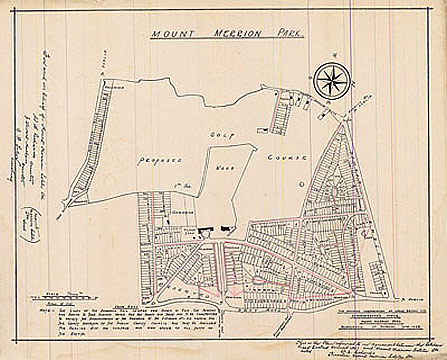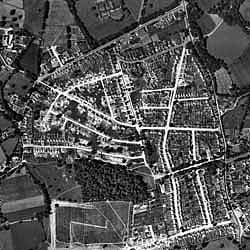HOUSING DEVELOPMENT
The first attempt at building modern houses on the Mount Merrion Estate seems to have been in 1926: Architects' plans were drawn up by the Housing Corporation of Great Britain and by 1928, five bungalows were built on Mount Anville Rd. A Mr. Cassels was appointed by the builder to look after the estate. He lived in the Chief Steward's Lodge which had an entrance from the orchard and a second entrance from Trees Road. The big selling point of the new Mount Merrion Park Estate was the brochure which stated "between Foster's Avenue and St. Thomas' Road is envisaged a boating lake with pleasure gardens and tennis courts, also a brook with miniature cascades, a bathing pool fed with fresh spring water which was to be located on The Rise, also a golf course where Glenabbey, Cedarmount, Redesdale and Upper Trees Road are now. The first tee was marked down on the map at the beginning of the Rose Walk which is off South Avenue and parallel to Glenabbey Road.
Houses on this plan sold very slowly. One of the first of five bungalows to be occupied was purchased by a Mr. and Mrs. Sutton on Mount Anville Road in 1928.
The price of these bungalows was £750 and they were built by a Mr. George Squire snr. The lighting and heating was by gas, as electricity had not arrived in Mount Merrion as yet. The brochure also indicated that there was a very good omnibus service to and from Mount Merrion Park. There was, for instance, the Dublin United Tramway Company Ltd. from O'Connell Bridge, whose first bus to Mount Merrion was 7.10 am and the last bus 11.20 pm with services from Dun Laoghaire and Bray also passing Mount Merrion. There was also the Robin Bus Company from Burgh Quay at 8.00 am in the morning and the last bus at 11.30 pm which continued on to Foxrock. Another early bus service to Foxrock was owned by Mr. Hoey who later sold the company to the General Omnibus Co. Also, the St. Kevin's Bus Service to Glendalough, owned by the Doyle Family of Roundwood, would stop anywhere on the route.

The bungalow top left 'Glengesh' was built in Mount Merrion in 1928...it is loacted just below the entrance to the Deerpark on Mount Anville Road. This would have been marketed as one of the 'labour saving' houses. The other pictures in this set were taken on Roebuck Avenue. showing housing, also from the late twenties...though first listed in Thoms Directory in the 30s.
Wilson had plans to develop the whole of Mount Merrion to include a 9-hole golf course around the The Deerpark and the Glenabbey area. Sales however were slow and Wilson was forced to mortgage most of the land.
The map below shows development plans drawn up by The Housing Corporation of Great Britain in June 1928.
listen to Gerard O' Kelly's interview with Kevin Barry and
Mrs. Sutton, talking about the early building development on the estate
John du Moulin and The Kenny-Built Houses
The du Moulin family originated in the Bordeaux region of France where they were wine producers and farmers. They exported their wine to England and heard that a lot of it was then trans-shipped to Ireland carrying a hefty markup. One of John’s great grand-fathers emigrated to Ireland and set up a wine importing business and a shop on St Stephen’s Green.
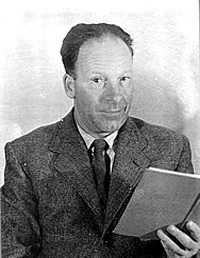
John du Moulin senior
Skip a few generations and John found himself as an apprentice in the Liffey Dockyards during the Irish Civil War. Work was slack so he enrolled in Bolton St. College in 1922. His lecturer was the distinguished English-born architect Rupert Jones. Probably because he was a mature student the two men became very good friends. Jones introduced Du Moulin to Limerick builder John Kenny in 1924.
Kenny recognized Du Moulin’s talent and he quickly became the second in command in the organization. Between 1924 and 1933 they built numerous schemes for Dublin City and Dublin County Councils in Little Bray, Ringsend, Donnycarney and Marino.
In December 1933 John Kenny of Irish Homes Ltd. bought the remainder of the Mount Merrion Estate (for £18000) from Guardian Assurance Co. with the help of the Trade Loans Act.
In November 1933 Kenny and Du Moulin walked the recently purchased lands in Mount Merrion and decided to immediately commence development of the site. Rupert Jones was engaged as architect and they proposed a beautiful, unique and innovative plan of modern homes, the likes of which had not been built in this country before.
John Du Moulin’s first child was born the day he saw the site for the first time (his wife was not impressed at the idea of him rushing off to walk a few fields while she was in labour). He had just built a beautiful new bungalow in Kimmage and bought himself a Norton motorcycle to get to the various sites. As soon as they bought Mount Merrion Kenny asked him to relocate there to manage the development of this wonderful new site. He built number one The Rise in 1934 and moved in just before work commenced on the rest of the site.
The development progressed well in 1935 and 1936. They had a very efficient joinery operation on Harcourt Road and the brickyard on The Rise churned out top quality cement blocks, red wall bricks, white concrete cappings for the walls and piers and a range of wonderful roof tiles. They ran a narrow-gauge rail system with wagons that tipped sideways from the yard to the individual sites.
| No. 1 Greenfield Road (house on right) | The white-capped pillars and red bricks |
In 1952 John Du Moulin's tender to build St. Thérèse Church in Mount Merrion was successful and work commenced in 1953. The church opened to wide acclaim in 1956. This was the beginning of a succession of 10 churches built for the Archdiocese.
During this time all the administration, stores and joinery were conducted in the “Yard” in 93 The Rise. The joinery operation enjoyed an excellent reputation and before it closed in 1987 it completed a major project for the huge mosque in Medina in Saudi Arabia. They made all the doors and windows out of solid teak. The doors were seven feet wide and four inches thick and each weighed a ton.
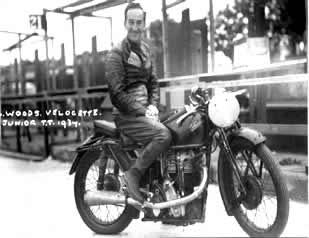
Stanley Woods
It was from his neighbour and friend Stanley Woods that John “Jnr” developed his love of speed and motor racing. He and his family later competed for years in both track and road races all over Ireland. Little wonder then that John “Jnr” was one of the first promoters of Mondello Park in Co. Kildare. Another neighbour Mr. Bonington who lived on The Rise had a flock of chickens and hens and willingly supplied his neighbours with fresh eggs each day during WW2.
His grandson, Chris Bonington, later became one of the best known mountain climbers and adventurers of modern times. He was knighted for his services to sport by Queen Elizabeth 2nd. In 1996.
Building of the first houses in the “Garden City” estate (No.1 Greenfield Road) commenced on Christmas Eve of 1934. Although Kenny had permission to build 20 houses per acre he chose to confine himself to 6 houses per acre, lay down wide roads and low white-capped red-brick walls in order to give the estate its renowned sense of spaciousness. His company baked the bricks in their own furnaces, had their own tile plant on The Rise and crafted the built-in furniture and windows in his own workshops in Adelaide Road. The tile plant on The Rise was located where the first four houses below SuperValu now stand. These houses were built by John du Moulin after Kenny went out of business.
In England an unprecedented boom in building was taking place in the period between 1925 and 1939: This marked the development of suburbia, with almost 4 million 'dream homes' being built on the green belt areas of the cities. Speculative builders targeted those tired of living in rented urban accommodation in the polluted atmosphere of the cities. Becoming an owner-occupier for less than the outgoings on rent and living in the country was becoming a very attractive proposition.
In the new Ireland of the 1930s, a civil servant, a teacher, or anybody in a permanent State job was a very likely candidate for ownership of one of the new houses in Mount Merrion. Mortgages were made available and affordable too, just like in England.
Advertising for the new 'Garden City' idyll in both England and Ireland was identical...references to ‘living in the country’, ‘within easy reach of the city'’ ‘space to breathe’, ‘space to live' were common themes. The new houses were marketed as 'Dream Homes' and they were...each was fitted with a bath, a WC, and hot and cold water available at the mere turn of a tap....even more importantly, electricity had arrived and was set to change the course of domestic history.
Kenny houses were all-electric and came fitted with electric lighting and sockets (220V two pin and side earth); this heralded a new and modern age. In this 'servantless' era labour saving devices like the electric iron, the washing machine and the Hoover were the 'must haves'. The houses which predated these had basements to accommodate servants. Special emphasis was placed on 'labour saving' kitchens and were so designed that less walking would be required to go from one area to another; some walls incorporated hatches, to pass meals from the kitchen into an adjoining dining room. In essence the 1930s home had all the old world charm of English 'vernacular architecture' with the latest in mod cons powered by electricity and gas.
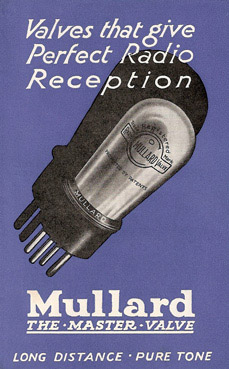
Just like the car, wireless sets were 'the must haves' of the day and the design of housing was tailored to that need; typically a sitting room comprised two armchairs at both sides of the fire with a settee at the opposite wall.
After all a sound source could be anywhere... you didn't have to see it!
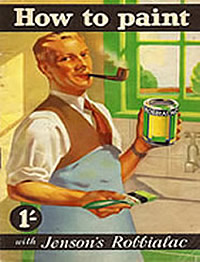
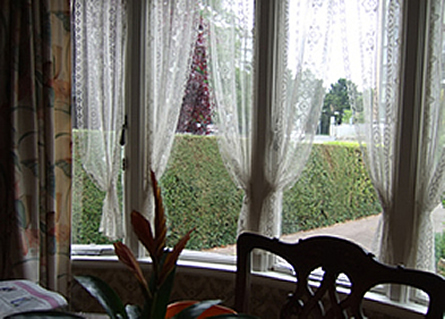
These houses were particularly right for their time and in the context of the1930s, very modern... however, many have had significant and necessary alterations carried out down the years. In most cases the fireplaces from the pre-central heating days of the thirties have been removed to make way for the 50-inch plasma TV screens of the 21st century.
There was a growing interest in interior design which was fuelled by the latest fashions seen in the local cinema. Magazines like Ideal Home, along with gardening, DIY, and of course wireless publications thrived.
The houses with their low front walls and wooden gates were perfect showcases for roses and the good taste of the owner. Almost every suburban house had a bay window —the essential mark of owner-occupation.
while perusing this page, enjoy some background music from
The Gerard O' Kelly Trio, recorded in Pigotts in 1946...
After building the houses on Greenfield Road, work commenced on both sides of Sycamore Road. Everything worked out fine until the two halves reached the beautiful old avenue. At this point, two huge trees blocked the passage into the present Sycamore Crescent. Permission was sought from the then tenant of the big house to allow them to be cut down. Instead of giving his permission, however, the owner went to court for an injunction to restrain their removal. The night before the injunction was due to be served, the builders hired a gang of men who worked all through the night cutting down the forbidden trees so the situation solved itself. This has paved the way for the present picturesque roundabout at Sycamore Crescent. The original intention was to build on both sides of the main avenue; the houses on Sycamore Road had been numbered to allow for this. When the plan was abandoned the present confusing numbering of Sycamore Crescent resulted. No. 15 Sycamore Crescent is practically beside No. 15 Sycamore Road.
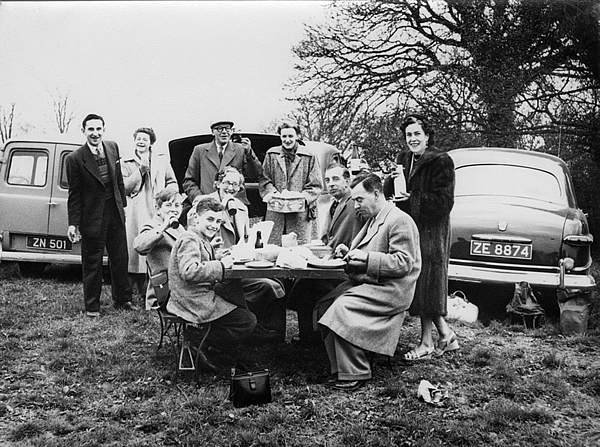
FAIRYHOUSE RACES 1950: John and Violet du Moulin centre back
John Whelan (quantity surveyor) and his wife Ethna right front
also Jim and Doreen McGrane
The first sign of anything going amiss was in early 1937. Kenny’s operations in his native Limerick (the graveyard of many a builder—as they said in the trade) were losing money and although Mount Merrion was very successful and selling well, it could not save the company in the longer term. All of this was further exacerbated by a 5-month-long builders' strike in 1938 and later with the outbreak of WW2. At this time number 72 and number 74 were the only houses built above the church car park on The Rise. The remaining houses on the upper part of The Rise were finished after the builders’ strike.
In the meantime John Du Moulin set out on his own. Thanks to his contacts with architects and builders supplies companies he got continuous work. He rented the yard in 93 The Rise in 1938 and later bought it.
During the Second World War (1939—1945) all building work stopped. Du Moulin was very lucky as he got a job as clerk of works in the turf camps in County Kildare. They supplied turf to the power stations as coal imports had all but ceased. That job lasted from 1941—1945. After the war a family friend who was both a solicitor and a developer helped him procure 7 sites on Ailesbury Road on which he built 7 large beautiful detached homes. These he sold for £6000 each... now he was back in business.
He purchased 20 sites on the lower end of The Rise, 10 on each side. Between 1948 and 1950 he built 20 houses there. He also built two detached houses on the North Avenue end of St. Thomas’ Road.
Click on this 1949 aerial photograph to see building work being carried out on 4 houses below SuperValu on The Rise. This used to be the spot where Kenny fired his red bricks for front walls and chimneys, The completion of these 4 houses was carried out by John du Moulin. who also built the Church of St. Thérèse.
His son John, is the present owner of the offices at 93 The Rise.
the transition from the 30s to the 50s... on the left a Kenny house built in the 1940s and onthe right one of the houses built by John Du Moulin in 1950; located just below SuperValu, this house used the latest in steel window- frame technology.
Architectural elements were borrowed from The International Moderne Movement, and from English vernacular styles.
The two pictures below show a Moderne Style building on the Stillorgan Road with its rounded 'sun trap windows' in steel. Other eamples of this style can be seen throughout Co. Dublin...in particular, along the Sutton Rd. and Knocksinna Rd. Foxrock, to name but a few.
The curved 'sun trap' window was incorporated into some of the Kenny houses as in the house on Sycamore Crescent (bottom left).
Half-timbering along with diamond patterned leaded glass was borrowed from the Tudor Gothic style as in the example bottom right found on Sycamore Road. Other examples of the 'Mock Tudor Style' can be seen in Ranelagh, Sydney Parade, and The Rock Road; many of these were built in the early 1900s.
The architectural styles of the 1930s were mixed and varied. The Kenny houses are a derivative of English vernacular architecture with other influences taken from Tudor, Art Deco, and even Continental Modernism, The picture shows traditional English building techniques and it's easy to see how it influenced 1930s suburban architecture.
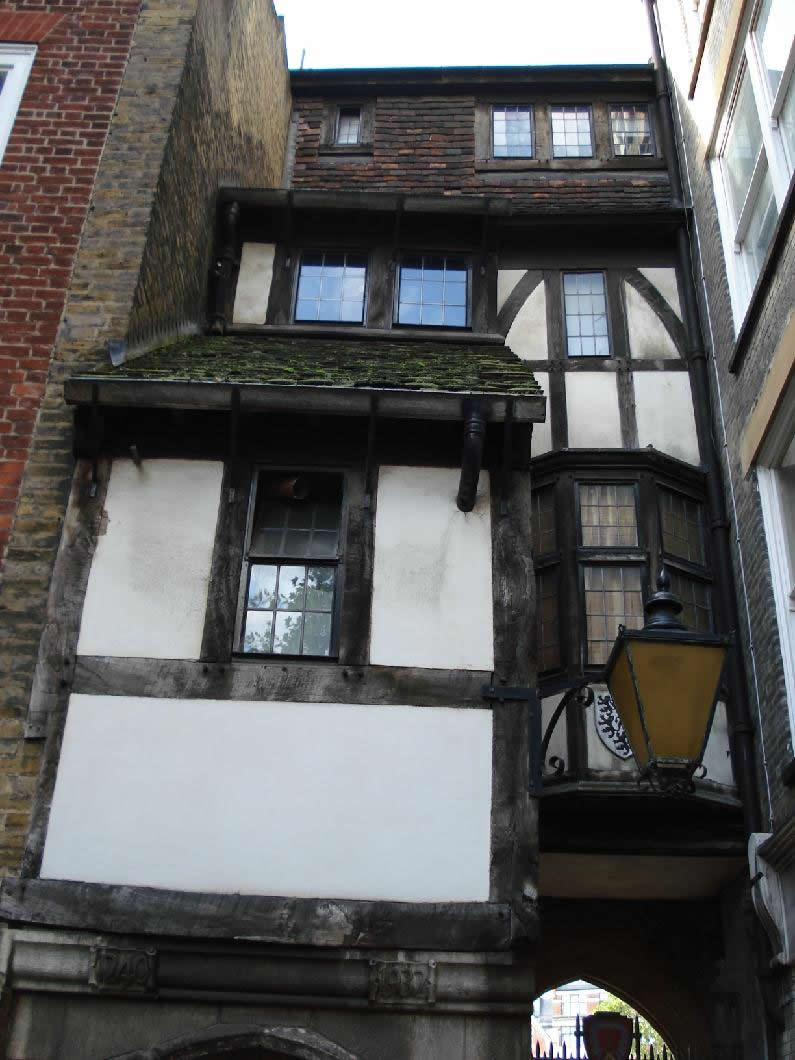
They are classed as Pseudo Historic, 'Inter War' or 'Tudorbethan', characterized by half-timbering (Mock Tudor), leaded lights, chrome door handles, bay windows, and stained glass doors.
Elements were borrowed from old and new to create a pastiche which was greatly frowned upon by architectural purists of the day, who favoured what was going on in Europe. Continental Modernism (eminating from Germany and Switzerland) was characterized by flat roofs with steel window frames, curved frontage and minimalism,where 'form follows function'.
The three pictures below show the very popular sun-ray motif of the 1950s...these examples were found on Redesdale Road and Trees Road Upper.
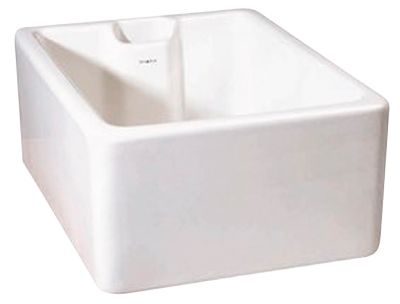
The Belfast Sink along with hardwood draining board was standard in every kitchen.

and few homes were complete without a set of ceramic flying ducks on the stairs wall.
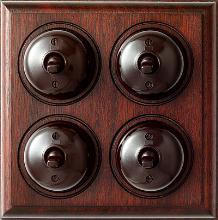
Bakelite was the plastic of the day and brought with it a
new streamline styling to product design; any shape could
be formed and different colours were available too.
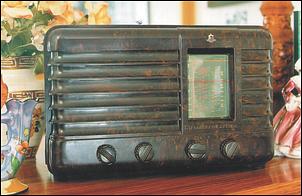
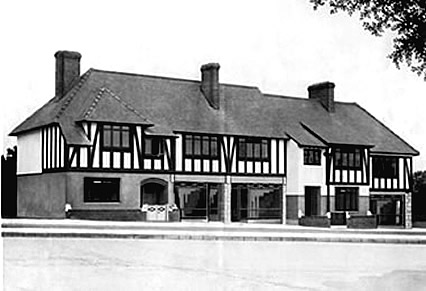
One of the first shopping centres was built on The Rise. The shops were Mrs. Legear, tobacconist and sweets, Mrs. Hendy, the chemist, and the Meagher family, "groceries with credit facilities and delivery service".
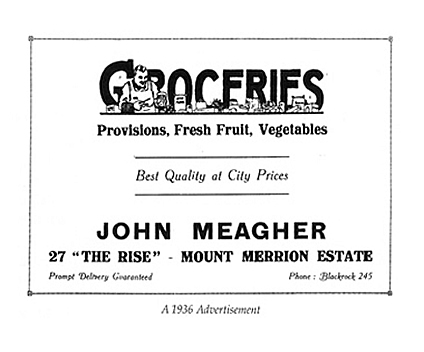
et plus ça change, plus c'est la même chose!
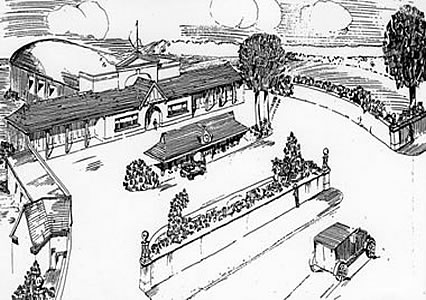
In 1936 a Mr. Eames built a new garage beside a gate-lodge inside the wall of the estate. The architect was certainly way ahead of his time... the petrol pumps had a canopy overhead to keep you dry on a rainy day... repairs were offered for all makes of cars... washing and greasing done while you waited, toilets were provided toilets. Attached were two shops which sold confectionery and vegetables. It was called the Estate Garage Ltd. it is now named 'On the Run'!.
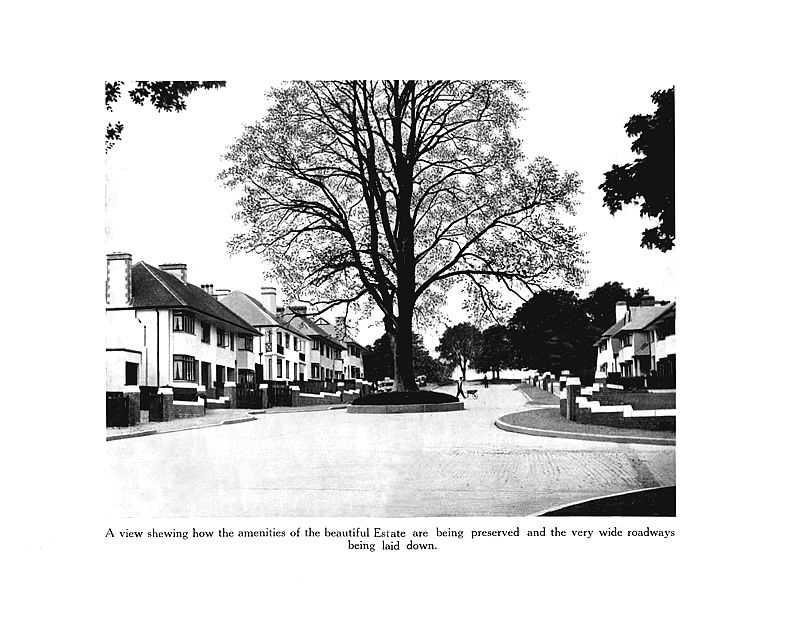
Housing development by date of the first appearance for each house in Thoms Directory.
Base map by openstreetmap.org contributors CC-by-SA.
The following pictures give an idea of the variety of design in the Kenny houses. Every house was different, down to the rendering on the walls and chimney brickwork; this was part of the appeal. The image to the left shows a typical wall render...it is one of many plastering effects produced by Kenny's men. whatever magic was in the mix and technique, it is seldom replicated well today. Most gates were wooden picket style and haven't stood the test of time. The steel variations drew on Art Deco themes.
A typical wooden gate used by John Kenny 1n the 1930s... most of these have not stood the test of time.
and an example of an Art Deco style steel gate also used by Kenny
A corbelled tile detail on a Kenny house
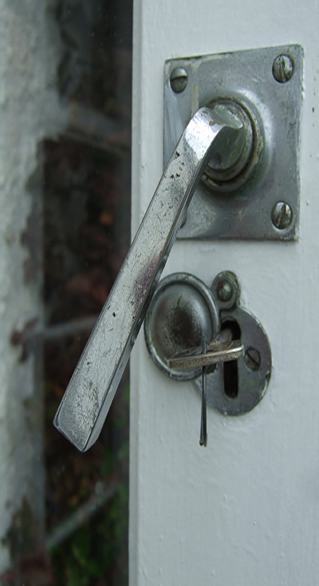
A typical door handle found in Kenny houses and to the left an art-deco window handle
screwed casement window commonly used by Kenny,...a uniformity in frame thickness is maintained by affixing blank non-opening windows alongside those that opened.This is not possible using aluminium or uPVC.
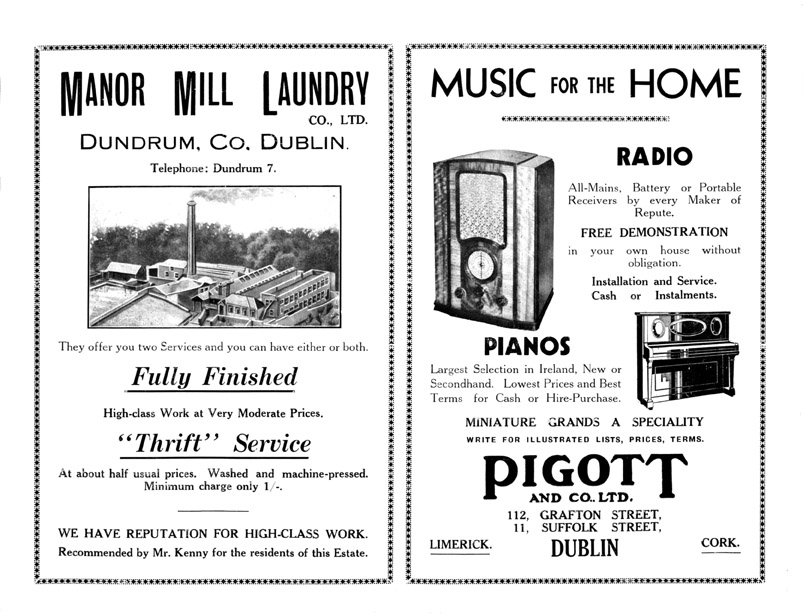
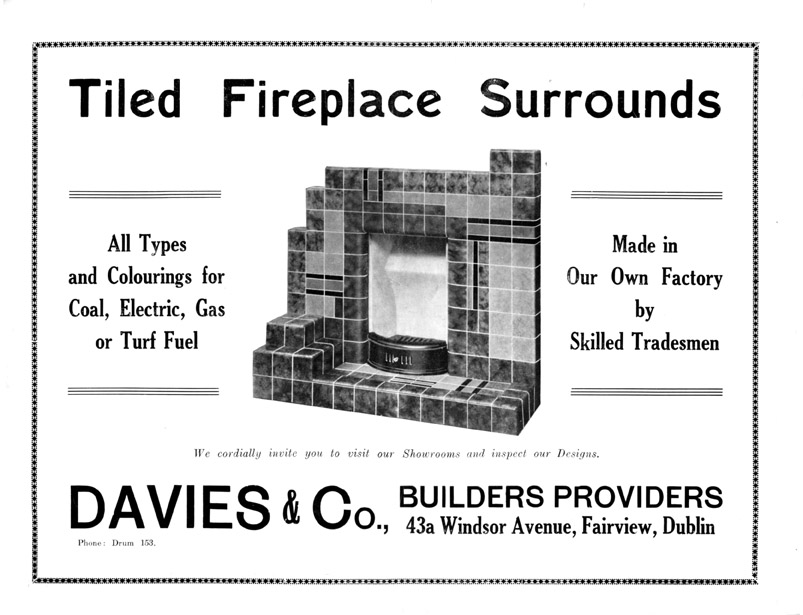
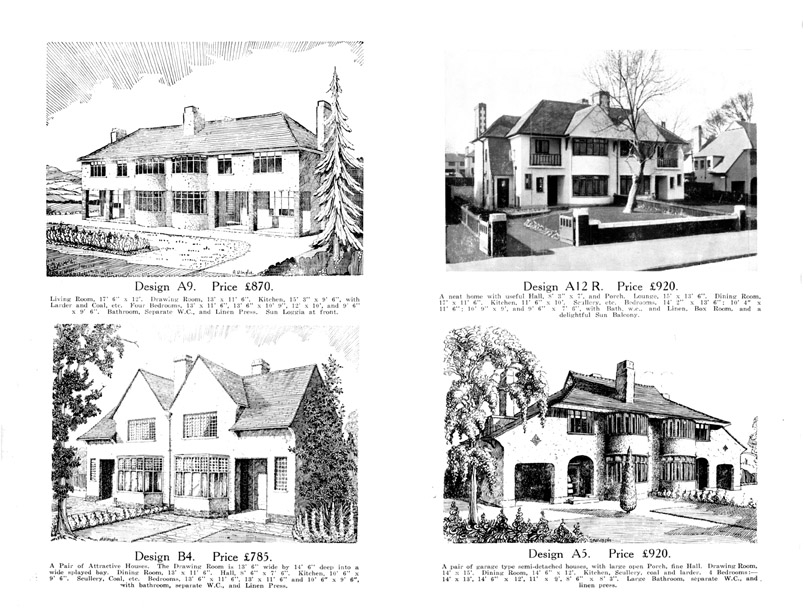
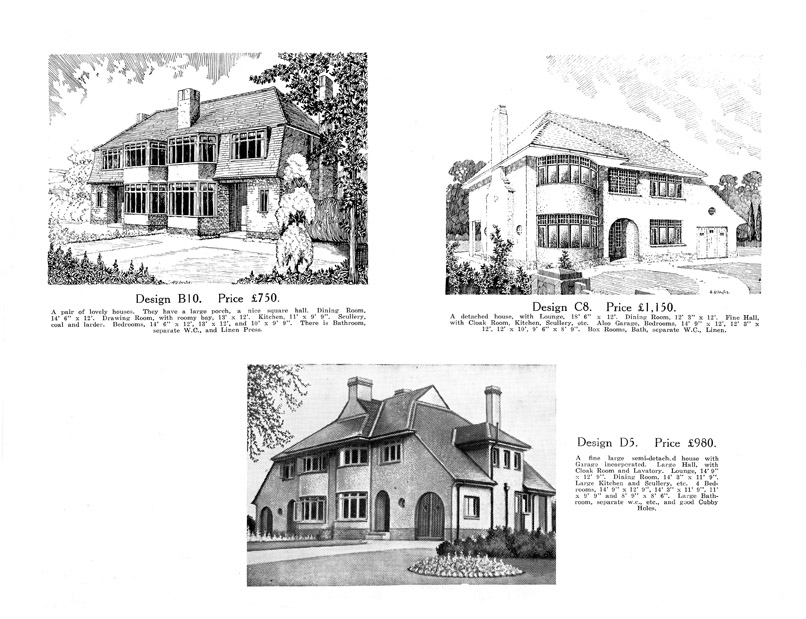
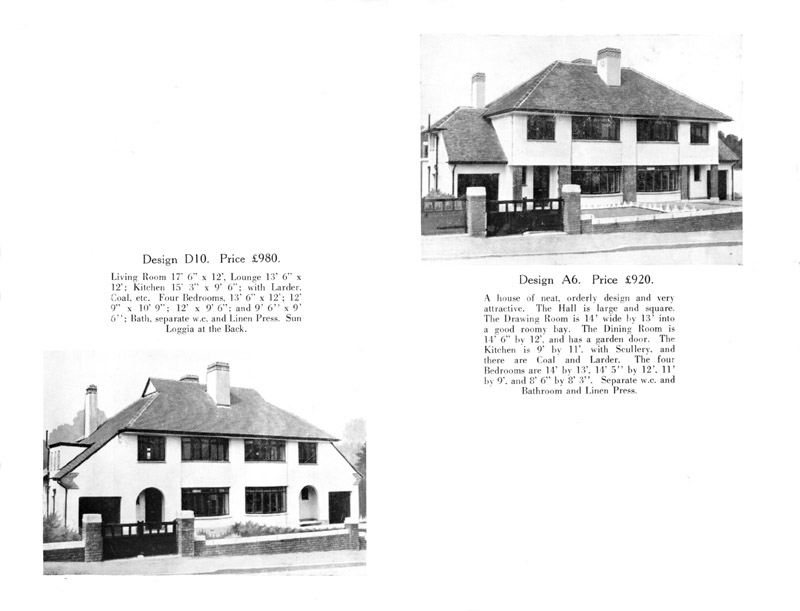
above, original pages from Irish Homes brochure circa 1936 and below the Kenny houses today...

